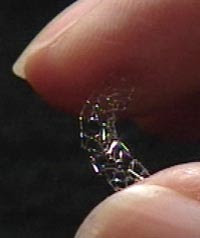Stone, G. W. et al. “Randomized comparison of everolimus-eluting and paclitaxel-eluting stents: two-year clinical follow-up from the Clinical Evaluation of the Xience V Everolimus Eluting Coronary Stent System in the Treatment of Patients with de novo Native Coronary Artery Lesions (SPIRIT) III trial.” Epubmed February 10 (2009): 119(5): 680-6.
Nikolosky E, et al. “SPIRIT IV trial design: a large-scale randomized comparison of everolimus-eluting stents and paclitazel-eluting stents in patients with coronary artery disease.” American Heart Journal. October 2009: 520-526.
As our understanding and usage of drug-eluting stents continues to improve and advance, better treatments for coronary artery lesions are surfacing. In a recent (2009) randomized comparison in the treatment of patients with de novo native coronary artery lesions known as the SPIRIT III trial, it was found that everolimus-eluting stents show better results than paclitaxel-eluting stents. Paclitaxel-eluting stents (PES) are currently widely used, but one could safely say that these will soon be replaced by everolimus-eluting stents (EES). Paclitaxel is a mitotic inhibitor used in cancer therapy, whereas everolimus, like sirolimus and zotolimus, works as an mTOR (mammalian target of rapamycin) inhibitor and is used as an immunosuppressant to prevent rejection of organ transplants. The comparison study found that patients treated with EES experienced statistically significant reduction in angiographic in-segment late loss at eight months, a surrogate marker for restenosis, and noninferior rates of target vessel failure (cardiac death, myocardial infarction, or target vessel revascularization) at 1 year. Additionally, these patients experienced significantly improved event-free survival at a 2-year follow-up in the SPIRIT III trial. Although further study is needed, the trends show that EES-treated patients are experiencing fewer stent thrombosis episodes after six months than PES-treated patients.


No comments:
Post a Comment